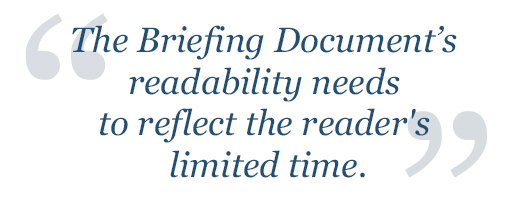Anyone who's ever prepared for an important meeting with the FDA is familiar with the concept of what the FDA calls an "Information Package." For an Advisory Committee meeting, however, this package, referred to as a Briefing Document, differs considerably from the one provided for an FDA review team. The appropriate FDA guidance states that the "information package should provide summary information relevant to the product(s) and any supplementary information needed to develop responses to issues raised by the sponsor, applicant, or reviewing division."
Consider Its Unique Purpose
Like the Advisory Committee meeting itself, the Briefing Document you will write for the meeting is unique. It's not only unlike other information packages, it's unlike any other piece of writing in the drug development process. It's not a regulatory document. It's not a scientific thesis. It's not an article for a scientific journal.
The Briefing Document is the home of scientific advocacy, the place where you advocate for your product with a group of readers who have the power to make recommendations on your fate. It's where you make your written case for approval, for your REMS, for your Phase IIIb programs, for your proposed patient population, for your dose. It's also where you respond to issues the FDA has identified in its review as well as any issues you know might arise in a review by the members of the committee who read your document.
Write for Its Diverse Audience
And what a group of readers it is.
It's composed of some mixture of best-in-class experts, generalist medical doctors and scientists, possibly pediatricians, a consumer representative, a patient representative, at least one biostatistician, and an industry representative. The FDA recruits these experts to serve on the panel; a full description of that and other FDA Advisory Committee purposes and processes can be accessed here.

The roster of Advisory Committee participants for a particular meeting will include some or all of its sitting members, experts who have been appointed to serve a four-year term. It is also likely to include Temporary Voting Members appointed to serve only for a specific AdComm meeting.
Because the FDA is required to publish the names of those scheduled to attend the meeting only 48 hours in advance, you'll be writing the Briefing Document for an audience whose members cannot all be identified at the time you're composing and revising it.
Recent conflict of interest rules make it difficult for the FDA to find people to serve on some Advisory Committees. Any expert who has an active financial role—more than $50K—with products in your therapeutic area can be excluded although waivers may be granted. Product or indication characteristics may also complicate the FDA's search process; the Agency may not be able to locate eminently qualified experts who are willing and available to participate in a specific committee meeting. Occasionally the FDA turns to panelists who are pediatricians because this group participates in fewer clinical trials, has fewer conflicts, and has an intense interest in how a product may suit a patient under 21 years old.
Accordingly, the readers of your Briefing Document may not all be top experts in your exact indication or therapeutic area. Company experts may know considerably more about both than some panelists. So remember that the audience for your Briefing Document is highly variable in function, in knowledge, in level of expertise. Remember, too, that some members of this audience may be mistrustful of industry motives.
Another audience consideration is that the average Advisory Committee member will read the Briefing Document while performing another job, one potentially involving medical treatment for serious illnesses. Few Advisory Committee members have the time to devote the kind of intense reading that the FDA gives to an Information Package. Instead, this reader must make time to read. If the meeting in question were to run over two days and include multiple products or issues, then the panelist would be faced with multiple Briefing Documents.
Ensure Ease of Readability and Clarity of Structure
The demands made by its unique purpose and audience also make demands on the Briefing Document's readability and structure.
Its readability needs to reflect the reader's limited time. A document that demonstrates too much resemblance to either a regulatory document or a complicated scientific treatise misses the needs of the AdComm audience. It has to be easily accessed and easily digestible. Its level of difficulty should approximate a pharmaceutical version of that found in general scientific journals like Scientific American.
Its structure also needs to reflect consideration of the reader's time constraints. The best Briefing Documents are those divided into two separate pieces: Clinical Overview and Exposition. These two sections roughly correspond to what we call scientific advocacy (the sponsor's case for its product) and the presentation and explanation of data.
As you structure the Briefing Document, you must ensure harmony between it and your Core Presentation: messages, issues, and responses. The Clinical Overview and the Core Presentation should be as parallel as possible, recognizing that the Briefing Document has to be submitted to the agency 22 business days prior to the meeting and that information you discover in that interim—especially what you get from the FDA's Information Package—may change the Core Presentation.
Nevertheless, you should create both together in parallel processes and note what you do change in the presentation so that you can address differences during the Q&A.

The Clinical Overview section presents the case for the product, introduces the primary issues, and provides the sponsor's responses to those issues. It can be read thoroughly in a 2-4 hour session. It presents data selectively and includes extensive cross-references to sections of the Exposition that provide more detailed support.
The Exposition closely resembles a common scientific document and can be arranged in a more traditional way:
- Disease and therapeutic void
- Mechanism of action
- Study design and conduct
- Efficacy results
- Safety results
- REMS (Risk Evaluation and Mitigation Strategies)
- Benefit/Risk or Conclusions
- Appendices
The sponsor can use appendices to focus on the needs of particular committee members, providing more intense expert views of things like Patient Reported Outcomes measurements, details of REMS, and special statistics concerns.
The sponsor must choose whether the Exposition section is issue-oriented or simply a presentation of data that is then interpreted in the Benefit/Risk or Conclusions section.
Work Toward an Acceptable Outcome
The best outcome of the Briefing Document, of course, would be that the Committee accept the sponsor's case without question. Occasionally this will happen, usually when the FDA's Information Package suggests that the review team has already accepted the sponsor's argument. Generally, however, the sponsor should be satisfied with a less ambitious outcome – that the committee understand the sponsor's position and supporting evidence, is open-minded, and is prepared to deal with any remaining issues during the Q&A session.





